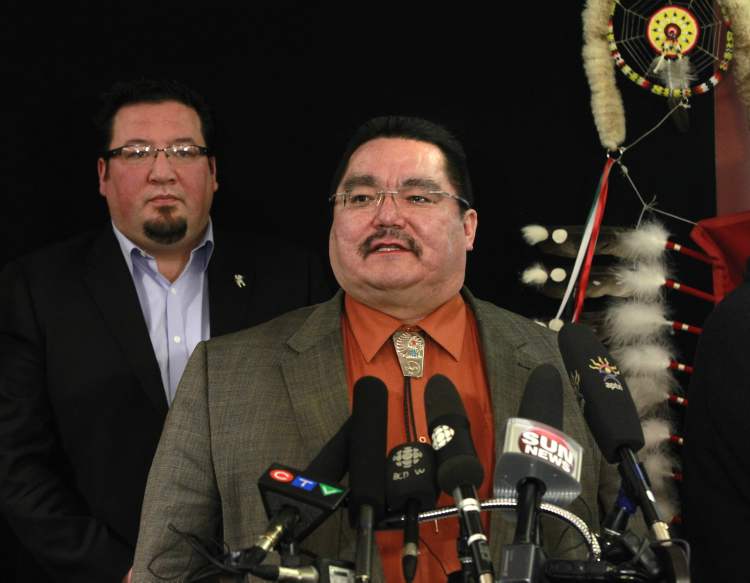Treaty 1 leaders win first battle over Kapyong Barracks
Advertisement
Read this article for free:
or
Already have an account? Log in here »
To continue reading, please subscribe:
Monthly Digital Subscription
$1 per week for 24 weeks*
- Enjoy unlimited reading on winnipegfreepress.com
- Read the E-Edition, our digital replica newspaper
- Access News Break, our award-winning app
- Play interactive puzzles
*Billed as $4.00 plus GST every four weeks. After 24 weeks, price increases to the regular rate of $19.00 plus GST every four weeks. Offer available to new and qualified returning subscribers only. Cancel any time.
Monthly Digital Subscription
$4.75/week*
- Enjoy unlimited reading on winnipegfreepress.com
- Read the E-Edition, our digital replica newspaper
- Access News Break, our award-winning app
- Play interactive puzzles
*Billed as $19 plus GST every four weeks. Cancel any time.
To continue reading, please subscribe:
Add Winnipeg Free Press access to your Brandon Sun subscription for only
$1 for the first 4 weeks*
*$1 will be added to your next bill. After your 4 weeks access is complete your rate will increase by $0.00 a X percent off the regular rate.
Read unlimited articles for free today:
or
Already have an account? Log in here »
Hey there, time traveller!
This article was published 15/12/2012 (4676 days ago), so information in it may no longer be current.
Aboriginal leaders celebrated a legal victory Friday they hope will force Ottawa to the negotiating table over the development of Winnipeg’s Kapyong Barracks.
A Federal Court judge ruled Ottawa must consult meaningfully with four Manitoba First Nations before selling 160 acres (65 hectares) of surplus federal military land west of Kenaston Boulevard at Grant Avenue.
Aboriginal leaders covet the prime land, which they say ought to go toward fulfilling unresolved treaty land entitlement claims. They’ve fought Ottawa in the courts since the federal Treasury Board, then run by Manitoba senior cabinet minister Vic Toews, ordered the land sold to the Canada Lands Co. for development in late 2007.

“This court challenge was to tell the government of Canada to stop taking our lands… and to stop denying us the economic opportunities that so many other Canadians take for granted,” Assembly of Manitoba Chiefs Grand Chief Derek Nepinak told a press conference at a downtown hotel.
The ruling Friday by Justice Roger T. Hughes does not hand the land over to First Nations people. But it forces the federal government to reckon with First Nations treaty rights concerning such properties.
Several First Nations leaders expressed hope Friday that a negotiated settlement can be reached with Ottawa over the land. The two sides were said to be close to a deal only a few weeks ago.
“Winnipeggers need not be afraid of this court decision,” Nepinak said. “First Nations leadership want nothing more than to help… our people acquire employment, housing and all of the opportunities afforded to other Manitobans.”
Glenn Hudson, chief of Peguis First Nation, one of the First Nations behind the lawsuit, foresees a mix of commercial and residential development — including highrise apartment buildings — for the Kapyong site that fits within city zoning laws.
Hudson called on the prime minister’s office to “have this land converted to the rightful owners of this land, that being the First Nations people. We want to create economic opportunities for our people, (an) economic development zone… .”
Along with Peguis, the court ruled Ottawa must also consult with Long Plain, Roseau River and Sandy Bay First Nations regarding the sale of the land.
The federal government appears willing to negotiate a sale of the Kapyong Barracks land to the Treaty 1 First Nations as long as the land is not turned into an urban reserve.
A source close to the negotiations who did not want to be identified said Friday’s court decision didn’t quite give First Nations the upper hand, but it puts them in a stronger position to capitalize on the situation. “It’s going to be dependent now on how far they want to take the claim,” the source said.
He said Ottawa is willing to participate if the First Nations want to buy the land for the 2007 list price of $8.6 million and then develop it as a private developer would. “There is an opportunity for them to make a lot of money on that,” he said.
However, he said if the First Nations want the land to become an urban reserve “that would be really challenging.”
The source said even if the First Nations ended up having a court agree they had a claim to the land — which has not yet happened — there is no guarantee Ottawa would agree to turn the land into a reserve.
Hudson said First Nations are open to the idea of developing the land without creating an urban reserve, but it’s up to Ottawa to come to the negotiating table.
larry.kusch@freepress.mb.ca mia.rabson@freepress.mb.ca
TIMELINE
2004
Princess Patricia’s Canadian Light Infantry unit ships out of the Kapyong Barracks and moves to CFB Shilo.
November 2007
Ottawa decides to sell 160 acres of Kapyong Barracks land to a Crown corporation for disposal.
January 2008
Seven Treaty 1 First Nations file a court case to halt the sale.
September 2009
A Federal Court judge rules Canada has a legal duty to consult First Nations before disposing of the property.
2011
Federal Court of Appeal sends the case back to the lower court to be heard again by a different judge. The higher court rules the reasons behind the original judge’s ruling were “inadequate.”
December 2012
Federal Court Justice Roger T. Hughes rules to halt the Kapyong sale until four Manitoba First Nations — Peguis, Long Plain, Roseau River and Sandy Bay — are consulted.




